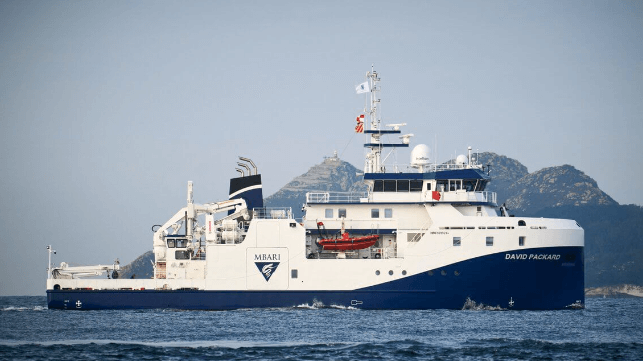California's MBARI Takes Delivery of a New Research Vessel

The California-based Monterey Bay Aquarium Research Institute (MBARI) is hoping to propel oceanographic research to the next level after taking delivery of its newest research vessel, a project that has taken over a decade to actualize.
MBARI announced that R/V David Packard has arrived at its headquarters in Moss Landing after completing a 59-day transit from Spain’s Freire Shipyard, where she was built at a cost of $50 million. The new ship is named after the institute’s founder, the late Silicon Valley innovator and ocean philanthropist David Packard.
Planning for David Packard, which was funded by the David and Lucile Packard Foundation, began in 2009 when the institute engaged U.S naval architecture and marine engineering firm Glosten to design the vessel. In 2021, the construction contract was awarded to Freire, a well-known specialty yard that also built the Schmidt Ocean Institute's R/V Falkor (Too).
The ship is a major addition to MBARI’s capabilities in ocean exploration. At 50 meters long, 12.8 meters wide with a draft of 3.7 meters, the new ship is bigger than its predecessor. The larger size will expand the institute’s ability to study marine life across the West Coast, from the Pacific Northwest to Baja California.
The David Packard will replace MBARI’s flagship research vessel, the Western Flyer, which was retired in 2022 and which was the institute’s workhorse for two and half decades. It now joins Rachel Carson and Paragon in MBARI’s fleet of research vessels.
Having arrived in Moss Landing, MBARI’s marine operations team is expected to take on the lengthy process of installing custom equipment and systems for oceanographic research. Also planned is a period in dry dock for maintenance and regulatory inspections before she can return to Moss Landing.
Science missions aboard David Packard, which can accommodate up to 12 crew members and 18 scientists for voyages lasting up to 10 days, will begin later this year.
“The ship will not only support advanced technology developed by the MBARI team but also promote collaboration across the marine science and technology community. Together, it’s all hands on deck to understand our changing ocean,” said Kaya Johnson, MBARI Director of Marine Operations.
The new ship boasts cutting edge technologies. It will serve as the command center for the institute’s remotely operated vehicle, Doc Ricketts, a robotic submersible that can dive up to 4,000 meters underwater. David Packard can also support the launch and recovery of autonomous technologies, including underwater vehicles that can map the seafloor, conduct visual surveys of the midwater, and monitor ocean health.
